Linghui Meng
ViLaS: Integrating Vision and Language into Automatic Speech Recognition
May 31, 2023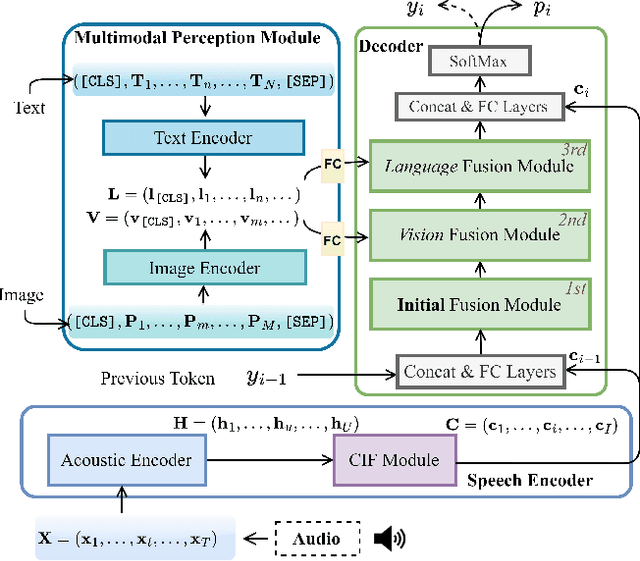

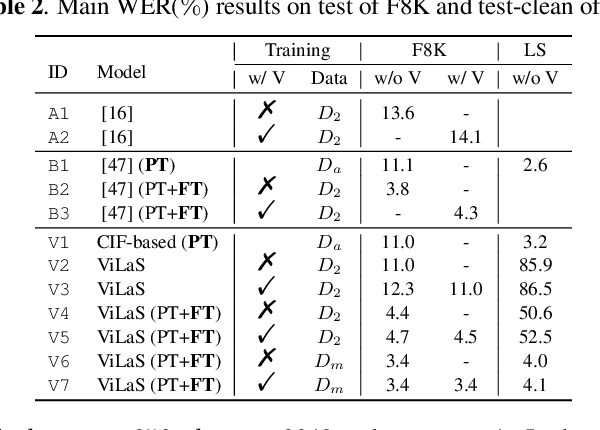
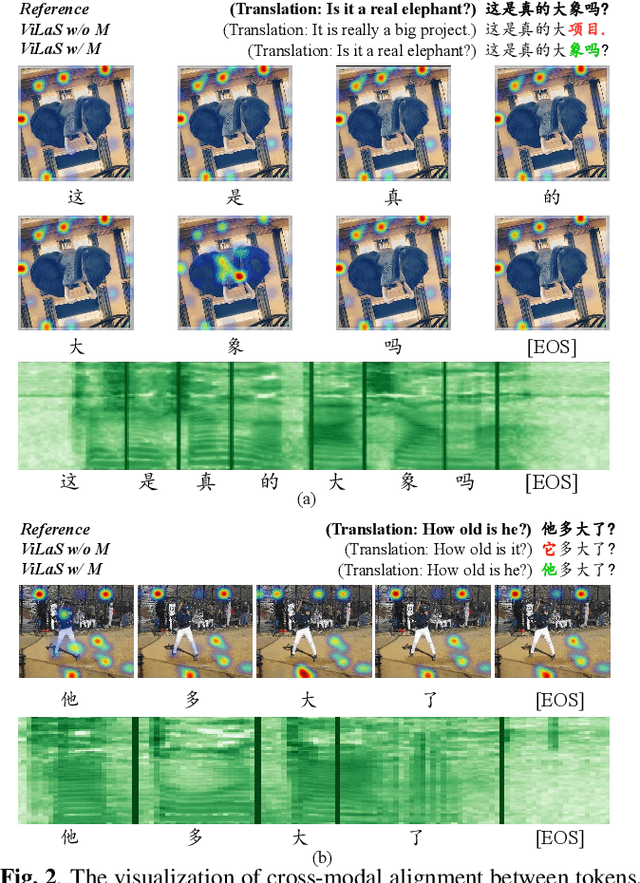
Abstract:Employing additional multimodal information to improve automatic speech recognition (ASR) performance has been proven effective in previous works. However, many of these works focus only on the utilization of visual cues from human lip motion. In fact, context-dependent visual and linguistic cues can also be used to improve ASR performance in many scenarios. In this paper, we first propose a multimodal ASR model (ViLaS) that can simultaneously or separately integrate visual and linguistic cues to help recognize the input speech, and introduce a training strategy that can improve performance in modal-incomplete test scenarios. Then, we create a multimodal ASR dataset (VSDial) with visual and linguistic cues to explore the effects of integrating vision and language. Finally, we report empirical results on the public Flickr8K and self-constructed VSDial datasets, investigate cross-modal fusion schemes, and analyze fine-grained cross-modal alignment on VSDial.
Mixture of personality improved Spiking actor network for efficient multi-agent cooperation
May 10, 2023



Abstract:Adaptive human-agent and agent-agent cooperation are becoming more and more critical in the research area of multi-agent reinforcement learning (MARL), where remarked progress has been made with the help of deep neural networks. However, many established algorithms can only perform well during the learning paradigm but exhibit poor generalization during cooperation with other unseen partners. The personality theory in cognitive psychology describes that humans can well handle the above cooperation challenge by predicting others' personalities first and then their complex actions. Inspired by this two-step psychology theory, we propose a biologically plausible mixture of personality (MoP) improved spiking actor network (SAN), whereby a determinantal point process is used to simulate the complex formation and integration of different types of personality in MoP, and dynamic and spiking neurons are incorporated into the SAN for the efficient reinforcement learning. The benchmark Overcooked task, containing a strong requirement for cooperative cooking, is selected to test the proposed MoP-SAN. The experimental results show that the MoP-SAN can achieve both high performances during not only the learning paradigm but also the generalization test (i.e., cooperation with other unseen agents) paradigm where most counterpart deep actor networks failed. Necessary ablation experiments and visualization analyses were conducted to explain why MoP and SAN are effective in multi-agent reinforcement learning scenarios while DNN performs poorly in the generalization test.
Offline Pre-trained Multi-Agent Decision Transformer: One Big Sequence Model Tackles All SMAC Tasks
Dec 20, 2021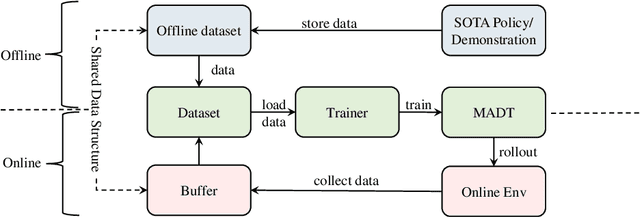
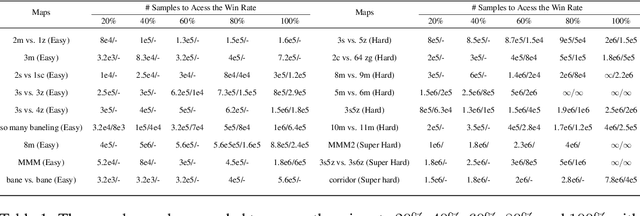
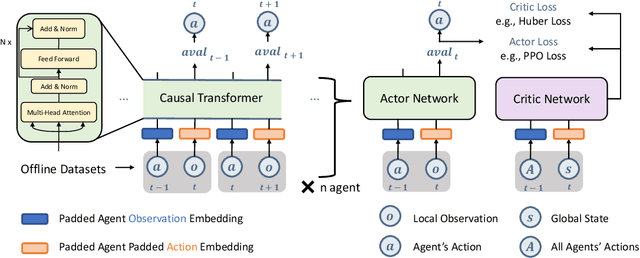
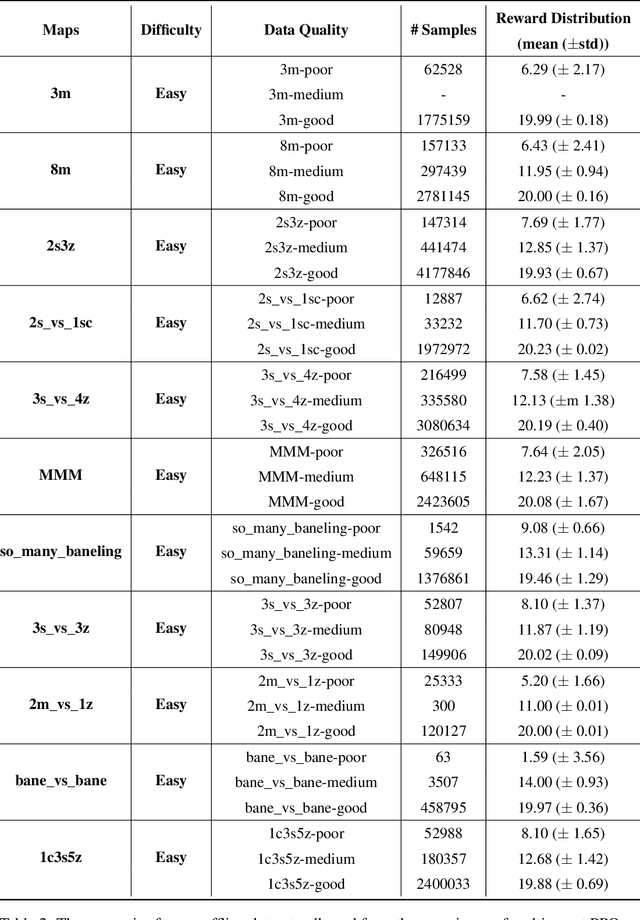
Abstract:Offline reinforcement learning leverages previously-collected offline datasets to learn optimal policies with no necessity to access the real environment. Such a paradigm is also desirable for multi-agent reinforcement learning (MARL) tasks, given the increased interactions among agents and with the enviroment. Yet, in MARL, the paradigm of offline pre-training with online fine-tuning has not been studied, nor datasets or benchmarks for offline MARL research are available. In this paper, we facilitate the research by providing large-scale datasets, and use them to examine the usage of the Decision Transformer in the context of MARL. We investigate the generalisation of MARL offline pre-training in the following three aspects: 1) between single agents and multiple agents, 2) from offline pretraining to the online fine-tuning, and 3) to that of multiple downstream tasks with few-shot and zero-shot capabilities. We start by introducing the first offline MARL dataset with diverse quality levels based on the StarCraftII environment, and then propose the novel architecture of multi-agent decision transformer (MADT) for effective offline learning. MADT leverages transformer's modelling ability of sequence modelling and integrates it seamlessly with both offline and online MARL tasks. A crucial benefit of MADT is that it learns generalizable policies that can transfer between different types of agents under different task scenarios. On StarCraft II offline dataset, MADT outperforms the state-of-the-art offline RL baselines. When applied to online tasks, the pre-trained MADT significantly improves sample efficiency, and enjoys strong performance both few-short and zero-shot cases. To our best knowledge, this is the first work that studies and demonstrates the effectiveness of offline pre-trained models in terms of sample efficiency and generalisability enhancements in MARL.
Settling the Variance of Multi-Agent Policy Gradients
Aug 20, 2021


Abstract:Policy gradient (PG) methods are popular reinforcement learning (RL) methods where a baseline is often applied to reduce the variance of gradient estimates. In multi-agent RL (MARL), although the PG theorem can be naturally extended, the effectiveness of multi-agent PG (MAPG) methods degrades as the variance of gradient estimates increases rapidly with the number of agents. In this paper, we offer a rigorous analysis of MAPG methods by, firstly, quantifying the contributions of the number of agents and agents' explorations to the variance of MAPG estimators. Based on this analysis, we derive the optimal baseline (OB) that achieves the minimal variance. In comparison to the OB, we measure the excess variance of existing MARL algorithms such as vanilla MAPG and COMA. Considering using deep neural networks, we also propose a surrogate version of OB, which can be seamlessly plugged into any existing PG methods in MARL. On benchmarks of Multi-Agent MuJoCo and StarCraft challenges, our OB technique effectively stabilises training and improves the performance of multi-agent PPO and COMA algorithms by a significant margin.
MixSpeech: Data Augmentation for Low-resource Automatic Speech Recognition
Feb 25, 2021


Abstract:In this paper, we propose MixSpeech, a simple yet effective data augmentation method based on mixup for automatic speech recognition (ASR). MixSpeech trains an ASR model by taking a weighted combination of two different speech features (e.g., mel-spectrograms or MFCC) as the input, and recognizing both text sequences, where the two recognition losses use the same combination weight. We apply MixSpeech on two popular end-to-end speech recognition models including LAS (Listen, Attend and Spell) and Transformer, and conduct experiments on several low-resource datasets including TIMIT, WSJ, and HKUST. Experimental results show that MixSpeech achieves better accuracy than the baseline models without data augmentation, and outperforms a strong data augmentation method SpecAugment on these recognition tasks. Specifically, MixSpeech outperforms SpecAugment with a relative PER improvement of 10.6$\%$ on TIMIT dataset, and achieves a strong WER of 4.7$\%$ on WSJ dataset.
 Add to Chrome
Add to Chrome Add to Firefox
Add to Firefox Add to Edge
Add to Edge